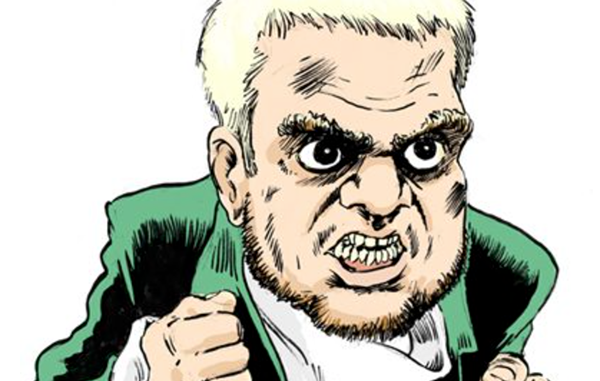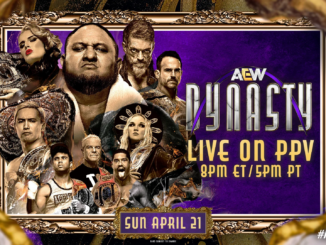
SPOTLIGHTED PODCAST ALERT (YOUR ARTICLE BEGINS A FEW INCHES DOWN)...
Two recently released pro wrestling books are very different in their subject matter, but both offer unique glimpses behind the curtain.
•First up, “Life is Short and So Am I: My Life Inside, Outside, and Under the Wrestling Ring,” by Dylan Postl a/k/a WWE’s Hornswoggle.
It’s another in a long line of wrestling autobiographies, but with a twist. Postl, who wrote the book with Ross Owen Williams and Ian Douglass, describes the challenges and rewards of breaking into the business as a little person, and managing expectations of the fans and other wrestlers versus the expectations he set for himself.
He comes across as clear-eyed and reflective not only of his time in wrestling, but with his family as well. Oftentimes in wrestling autobiographies, wrestlers discussing their upbringing is just window dressing, something necessary to complete the picture.
Readers are generally more interested in the behind-the-scenes dirt of the industry. I found myself just as captivated by Postl’s complicated relationship with his father and mother. He seems honest and forthright about mistakes he made in handling those relationships.
Then of course, there’s the wrestling. With a gimmick like Hornswoggle, Postl was knee-deep in some of the most outrageous storylines and angles in WWE during his time with the company. It’s fascinating to read not only his thoughts on those particular segments, but also the thoughts of others in the company, specifically those he was working with at the time.
Postl broke into WWE as the “son” of Finlay at a time when the current backstage producer was still an active competitor. It was cool to read about Postl’s connection with Finlay and how it continued throughout both of their WWE runs. Just as Finlay was Postl’s on-screen protector, he seemed to play that role behind the scenes as well.
One of the questions many wrestling fans likely have is, “how can you stand being under the ring for so long?” The Hornswoggle character basically lived under the ring and would appear from there more often than from backstage.
Postl answers that question in detail, with some funny anecdotes in accompaniment. Having grown up a fan of the business, Postl also talks about meeting some of his childhood heroes, all the while trying not to appear as a mark for the business. Backstage etiquette is weird like that.
One of the strangest detours Postl writes about is when he appeared for the WWE Films movie Leprechaun: Origins. It’s a section of the book that’s a good reminder that while there are many benefits to a company being as large and having as many tentacles as WWE, there are also some major downsides to it in terms of communication among departments and creative components.
There were times throughout the book where the warts of WWE’s creative process came to the surface. This could’ve just been shorthand by Postl for something that was really more thought-out, but the amount of times a storyline was given up on or radically changed with the excuse that “well, no one’s going to remember that,” or “no one cares about that,” is genuinely worrisome.
Intentional or not, it came across in the book as if some in WWE truly relish how nonsensical some of their storylines can become. It’s almost the attitude of, “it’s no big deal, it’s just wrestling,” which is how you end up hemorrhaging the kinds of viewership numbers we’ve seen over the years.
In addition to being a part of some wild and wacky lower card stories, Hornswoggle was also a part of a few major feuds. He was active in Money in the Bank matches, was part of the rebooted Degeneration X, and was eventually revealed as the Anonymous Raw General Manager.
One of his proudest moments was the Wee-L-C match against El Torito at Extreme Rules. He didn’t have much of import to do after that, was eventually suspended for a Wellness Policy violation (which he discusses in-depth) and subsequently released.
Postl has kept busy, making cameo appearances for WWE over the years as well as being a part of TNA, most notably on the Total Nonstop Deletion episode of Impact Wrestling TV. Overcoming the odds is a major theme in Postl’s life story, and he was able to do it to the point that he reached the pinnacle of sports entertainment.
•While not an autobiography, “The Pro Wrestling Hall of Fame: The Storytellers, from the Terrible Turk to Twitter” by Greg Oliver and Steven Johnson, is just as enthralling a read for different reasons. This book is the fifth and possibly last in the acclaimed “The Pro Wrestling Hall of Fame” series by Oliver and Johnson, following in the footsteps of “The Canadians,” “The Tag Teams,” “The Heels,” and “Heroes & Icons.”
This tome focuses on how the in-and-out-of-ring stories have developed in the pro wrestling industry from the very early days to today. The research undertaken by Oliver and Johnson to unearth some of the earliest newspaper coverage of pro wrestling is breathtaking.
What really struck me in reading this book is just how wrestling was covered by newspapers around the turn of the 20th century. Not only were the results printed and written about, often tongue-in-cheek, but the flowery prose of those writers put to shame the staid and stale newspaper copy of today.
As voracious of a reader as I’ve been when it comes to pro wrestling history, there were many names in the first few chapters of the book with which I was unfamiliar. Some for good reason, as they didn’t necessarily leave a lasting impact on the business, but still played an interesting role in the early days.
The outrageous way promoters and wrestlers stimulated their craft a century ago disabuses the notion that wrestling was always an all-class affair with only the likes of Lou Thesz and George Hackenschmidt. They played a major role, yes, but so did the wrestlers who fought bears, or who wrestled in mud, or who were attractions because of their sizeable dimensions.
As Oliver and Johnson work their way through wrestling history, you can see how the business changes over time in terms of how stories are told. There was the famous Verne Gagne Minnesota training camp that produced the likes of Ric Flair and the Iron Sheik.
There were the announcers, whose job it was to get across the personality of the wrestlers and sometimes, when called upon, become part of the story themselves. There were the celebrities, trainers, jobbers, all who play their own part in getting over the mat game.
The discussion of job guys, especially those I grew up watching in the late 80s and early 90s, I found really interesting. Unless you’re a student of shoot videos, there really aren’t a lot of other places that give space to those wrestlers, their mindset, and what they do.
Wrestling seems to be slowly embracing the squash matches again today, though I don’t think we’ll ever have the weekly job guys like Barry Horowitz and Reno Riggins that a previous generation had. In the more modern chapters, the authors give credit to newsstand magazines and newsletters like this one for the development and coverage of the industry.
Of course, the Attitude Era gets a chapter unto itself with insight into the creation of the New World Order as well as the episode of Monday Night Raw when Shawn Michaels collapsed in the ring in a match against Owen Hart, playing off the real-life attack he suffered weeks before outside a nightclub in Syracuse, New York. Hello, reality era.
The authors talked to Eric Bischoff, who gave his philosophy on storytelling in pro wrestling. I wish we could’ve seen him helm Smackdown for longer to test that philosophy, as his explanation made a lot of sense. Who knows if it would’ve passed the Vince McMahon smell test, however.
One of the final chapters discusses the advent of the writing teams in WWE, plucking Hollywood scriptwriters to pen television. To listeners of Wade Keller’s interviews with numerous creative team members through the years, nothing said will likely surprise anyone: The writers seem to have both positive and negative memories of working there, with the scales tipping slightly one way or the other depending on the particular writer’s experiences.
The best line in the book though comes from Dan Madigan, former WWE Smackdown writer and the man who wrote the Kane-led See No Evil movie, where he compared professional wrestling to the stories in the Bible.
If you’re looking for a book to get a fellow wrestling fan this holiday season, or are just looking for one for yourself, you can’t go wrong with either “Life is Short and So Am I” or “The Pro Wrestling Hall of Fame: The Storytellers.” Both are published by ECW Press and are available through their website or wherever books are sold.




Leave a Reply
You must be logged in to post a comment.